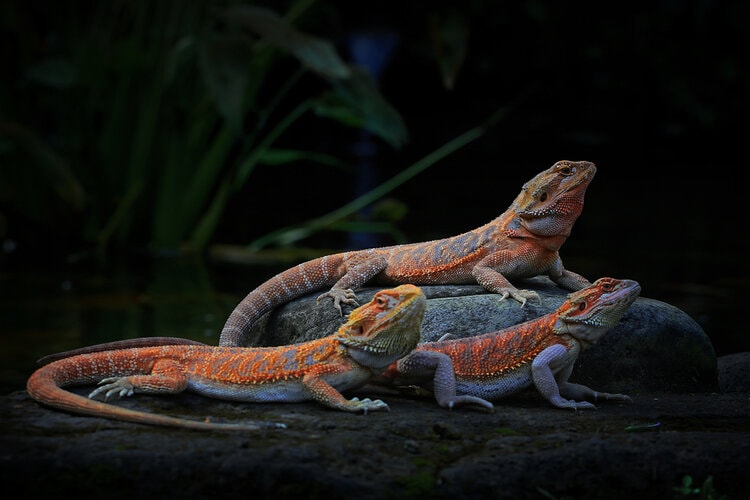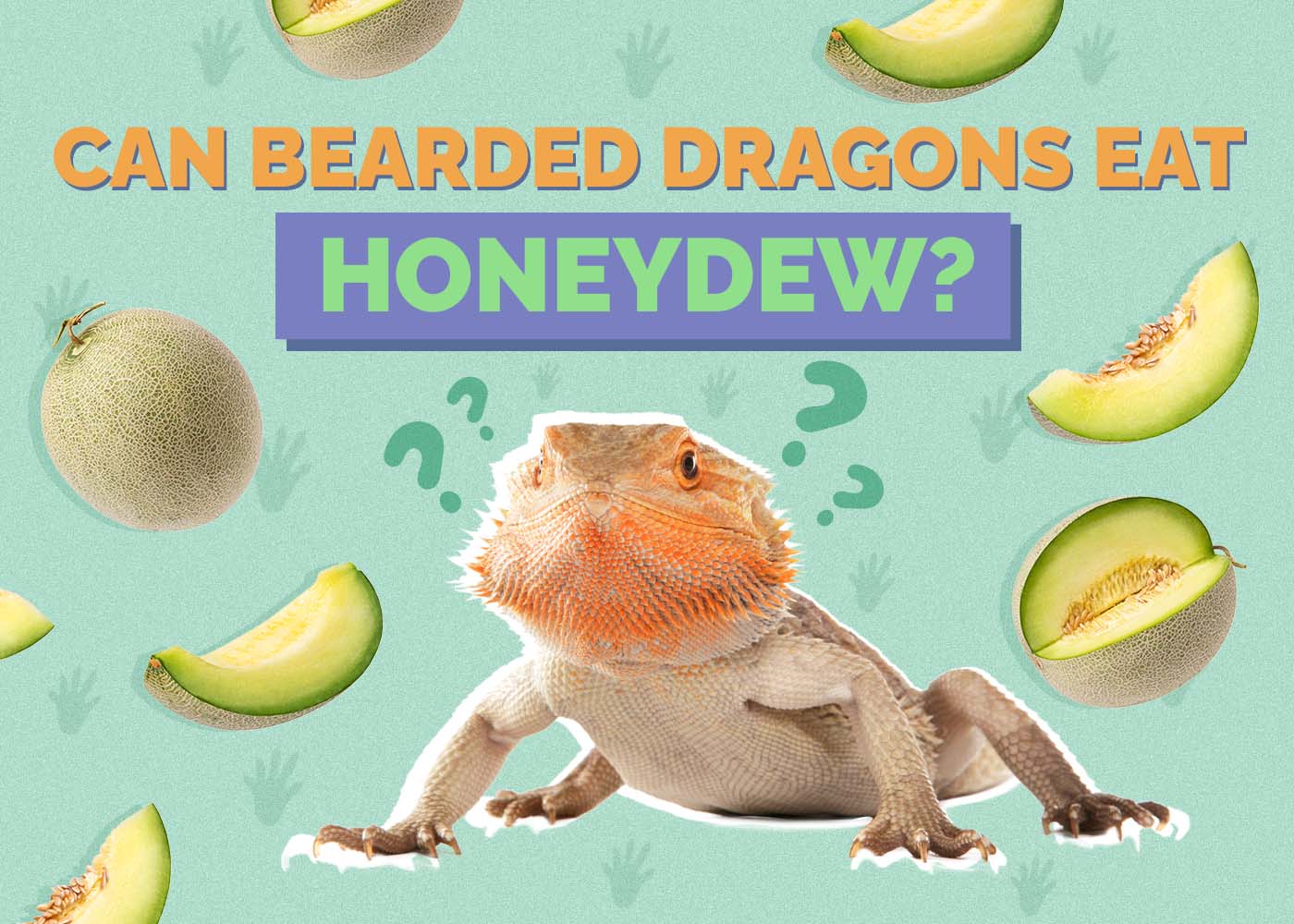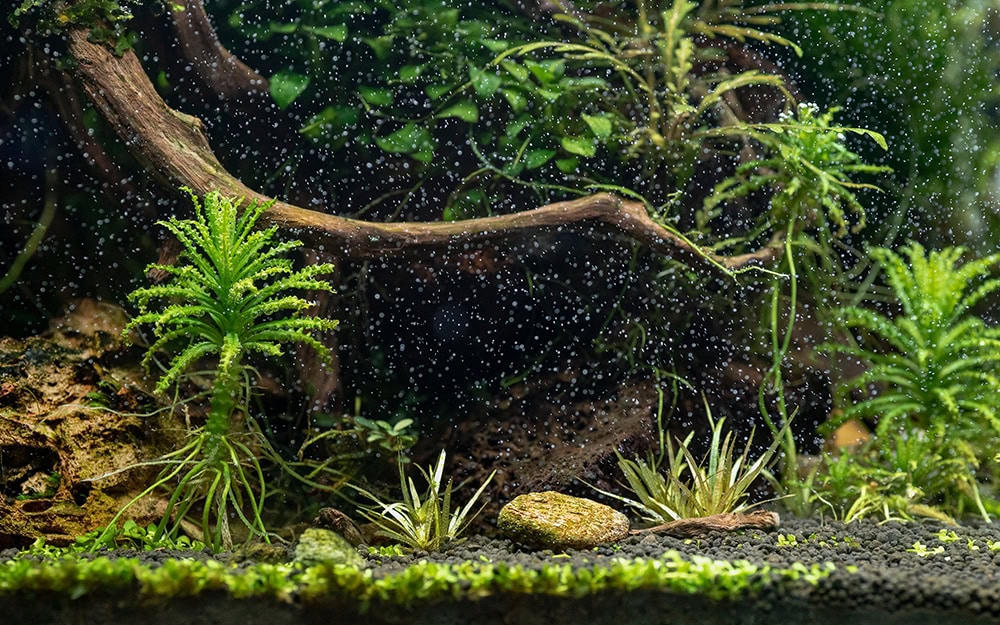Paradox Bearded Dragon: Facts, Pictures, Habitat & Care Guide
Updated on

As a pet reptile, Bearded Dragons are quite popular to keep in captivity, and they make fun and fascinating pets when cared for properly. Out of all the different Bearded Dragon morphs you get, the Paradox Bearded Dragon is one of the rarest you can own. This morph of Bearded Dragon stands out in comparison to the tan and brown shades commonly seen in wild-type Bearded Dragons with more uncommon colors or random patches instead.
If you are lucky enough to own a Paradox Bearded Dragon, you will find that they are great pets to care for and their unique coloring is a sight to see.

Quick Facts about Paradox-Bearded Dragons
| Species Name: | Pogona vitticeps |
| Common Name: | Paradox Bearded Dragon |
| Care Level: | Moderate |
| Lifespan: | 8 to 12 years |
| Adult Size: | 10 to 12 inches |
| Diet: | Omnivores |
| Minimum Tank Size: | 75 gallons |
| Temperature & Humidity | 80–90 degrees Fahrenheit and 30%–40% humidity |
Do Paradox Bearded Dragons Make Good Pets?
Paradox Bearded Dragons make great pets, and they have the same care requirements as other captive-bred Bearded Dragons. They are a type of exotic pet that needs an owner that can research and provide them with specific living conditions to ensure they are kept healthy. Most Bearded Dragons will be friendly toward their owners, but they aren’t the cuddliest pets. While some Bearded Dragons will get comfortable being handled by their owners, they won’t be as affectionate and interact with you as a dog or a cat would.
However, the Paradox Bearded Dragon requires daily ongoing care, so you will need to feed them and maintain their enclosure every day.
Appearance
The Paradox Bearded Dragon is a rarer morph or color mutation of a Bearded Dragon and not a different species. Morph refers to the physical characteristics of the Bearded Dragon, such as their coloring. Paradox Bearded Dragons grow to an adult size of 10 to 12 inches in length and they can weigh around 0.62 to 1.3 pounds in size.
The Paradox Bearded Dragon will have patches of color, no color, or some translucent scales on their body with random patches of colors. Some Paradox Bearded Dragons can also have a purplish coloration, referred to as Purple Paradox Bearded Dragons. These Bearded Dragons can have either big or small blotches of color on them, while others can have nearly undetectable patches of color or none.
How to Take Care of Paradox-Bearded Dragons
Enclosure
The Paradox Bearded Dragon requires a roomy enclosure, and a good minimum size to start with is a 75-gallon glass tank. If you can, getting a much larger enclosure from the start will save you money from having to upgrade the enclosure in the future.
Aside from a glass tank, you can also purchase wooden or acrylic enclosures that can be custom-made to your preferred dimensions. The enclosure will need to have a mesh screen to prevent your Bearded Dragon from escaping and offer plenty of ventilation and floor space.
Once you have your Paradox Bearded Dragon’s enclosure all set up, you will need to regularly maintain it. The water and food bowl should be cleaned under warm water with a reptile-safe soap to remove dirt and build-up. Any poop should be spot-cleaned every day or every second day, and leftover insects that your Bearded Dragon didn’t eat should be removed.
Lighting
A quality reptile fluorescent bulb is necessary for your Paradox Bearded Dragon and it will provide them with the UVB and UVA that they need to produce vitamin D3. Your Dragon will not be able to get these light rays from natural light through a window, and direct sunlight on the enclosure can affect the temperature.
Artificial lighting will be the best option for your Dragon. Without UVB and UVA lighting, your Dragon is at risk of developing metabolic bone disease (MBD). The lights should ideally be kept on for 12 to 14 hours a day, with the rest being a period of darkness during the night.
Heating (Temperature & Humidity)
Heating is essential for Bearded Dragons and your Dragon can get sick if they are kept too chilled or with constantly fluctuating temperatures. Their external heat sources must be safe for Dragons and running all the time. A ceramic heat emitter (CHE) is going to be the best heating option for your Dragon, but you can also use a mercury bulb. They require a basking spot in the enclosure where the heating bulb is placed 12 inches away from your reptile to prevent it from burning them.
The basking area should be between 95 to 105 degrees Fahrenheit, while the rest of the enclosure has a temperature gradient of 80 to 90 degrees Fahrenheit. The warmer temperatures allow your Bearded Dragon to digest their food. Humidity is important for Dragons because of their shedding, so maintaining a humidity level of 30% to 40% in the enclosure is ideal.
Substrate
Most Bearded Dragons will enjoy digging in their substrate, which is why substrates such as the ZooMed excavator clay are recommended. However, you can also keep your Bearded Dragon on reptile carpets, ceramic tiles, and reptile floor liners if you find that a substrate is too difficult to maintain.
| Enclosure Recommendations | |
| Tank Type | 75-gallon glass tank |
| Lighting | Fluorescent lighting with UVB and A |
| Heating | Ceramic heat emitter (CHE), mercury bulb |
| Best Substrate | Reptile carpet, reptile excavator clay |
Feeding Your Paradox-Bearded Dragon
The Paradox Bearded Dragon is an omnivore, and their diet consists of live insects, fruits, and vegetables. You will also need to supplement your Bearded Dragon’s diet with a calcium supplement that contains vitamin d3 and a multivitamin for reptiles. Younger Bearded Dragons are mostly insectivores and eat a lot more insects than adults. As your Bearded Dragon reaches its adult size, they can be fed a mixture of insect protein like dubia roaches, mealworms, or crickets, and fresh foods like blueberries, apples, dandelion leaves, and collard greens. Any insects that you feed your Dragon should be no larger than the space between their eyes.
| Diet Summary | |
| Fruits | 5% of the diet |
| Insects | 35% of the diet |
| Vegetables/fresh foods | 60% of the diet |
| Supplements Required | Reptile calcium (with vitamin D3), multivitamins |
Keeping Your Paradox-Bearded Dragon Healthy
It’s easy to keep Paradox Bearded Dragons healthy when they are cared for properly, and they can live for up to 10 years. However, Paradox Bearded Dragons can be born with certain health issues or defects more often than other morphs. The predisposed health issues are usually caused by the parents since you will need to mix certain types of Bearded Dragons to get the paradox mutation. Crossbreeding can lead to the offspring having more health issues, even if the parents were healthy before being bred.
Common Health Issues
Aside from any deformities or defects that Paradox Bearded Dragons may have from birth; they are still prone to various health issues like any other Bearded Dragon is. If your Paradox Bearded Dragon is sick, they will require treatment from an exotic veterinarian.
- Metabolic bone disease (MBD): MBD is caused by improper feeding or exposure to UVB lighting. The Bearded Dragon is unable to synthesize vitamin d3 and the disease results in soft bones, swelling near the jaw, weakness, and fibrous osteodystrophy of the hind limbs.
- Impaction: A Bearded Dragon’s digestive system can become blocked due to undigested foods, consuming sand or gravel-like substrates, and other undigestible objects. This can lead to weight loss, mobility issues, and spinal bulging.
- CANV (Chrysosporium anamorph of Nannizziopsis vreisii): A fatal fungal infection that causes yellow plaque on the Bearded Dragons’ bodies that can crack and peel if left untreated.
- Atadenovirus: Although common in younger Bearded Dragons, it can affect them at any age. It’s caused by liver and gastrointestinal infections and prevents them from growing at a normal rate.
- Infectious stomatitis: Caused by a bacterial infection in the Bearded Dragon’s mouth that causes swelling, excessive mucous production, and gum hemorrhages.
- Respiratory infections: Low temperatures, stress, and high humidity may lead to respiratory infection in Bearded Dragons caused by either a fungus, virus, bacteria or even parasites.
Lifespan
In comparison to other types of pet reptiles, a Bearded Dragon has a relatively short lifespan. Most Bearded Dragons only live for 5 to 8 years in the wild, but in captivity, they can live for 8 to 12 years. The healthier and more well-cared for your paradox Bearded Dragon is, the longer they can live.
Breeding
Unless you are an ethical and experienced breeder, you shouldn’t be breeding to achieve a Paradox Bearded Dragon. This is because they are prone to health issues from birth, and you cannot get another Paradox morph by breeding two Paradox Bearded Dragons together. They are usually created by crossbreeding hypomelanistic, translucent, witblit, or zero Bearded Dragons together. This morph or mutation is not from the standard recessive or dominant genes.
Are Paradox Bearded Dragons Friendly? Our Handling Advice
While Bearded Dragons in general are described as friendly, social, and holdable, it greatly depends on your paradox Bearded Dragon’s personality. Some Paradox Bearded Dragons can be more friendly than others, especially if they were handled properly from a young age. However, Bearded Dragons are not aggressive animals and will rarely bite unless they feel threatened.
You should always hold your paradox Bearded Dragon with clean hands-free from lotions, scented soaps, or perfumes that can irritate. Handling them over a soft surface while sitting down can prevent them from falling out of your hands if they become startled. An adult Paradox Bearded Dragon is going to be easier to handle than a baby or juvenile since they have a larger size.
Shedding & Brumation: What to Expect
Paradox Bearded Dragons grow by shedding their skin, and it comes off in visible patches. The younger the Bearded Dragon is, the more often they will shed. Ensuring that their living conditions are suitable will make the shedding process a lot easier for your Dragon and prevent them from getting stuck shed. Aside from the correct temperature and humidity, nutrition is important for their shedding.
Brumation occurs for reptiles like Bearded Dragons at least once a year during the colder months. Bearded Dragons must do this in the wild because they need heat to digest their food properly. By brumating, a Bearded Dragon can conserve their energy. While brumation might be okay for older Bearded Dragons, it’s not recommended to let them brumate under a year old when they are doing most of their growth.
How Much Do Paradox Bearded Dragons Cost?
Due to the Paradox Bearded Dragon being a rarer morph, they are higher priced than the average Bearded Dragon. Depending on the rarity of their coloring and their placement, Paradox Bearded Dragons can cost anywhere from $1,000 to $2,000. A breeder will sell them for a much higher price than a pet store will, but you are more likely to get a healthier Paradox Bearded Dragon from a reputable breeder.
Care Guide Summary
- Ideal size for handling
- Social and docile
- Active during the day (diurnal)
- Prone to various health issues from birth
- Expensive
- Should be housed alone

Conclusion
The unique and rare Paradox Bearded Dragon has random colors and patterns that make them look striking. While they do make great pets if you can care for them properly, many Paradox Bearded Dragons are predisposed to health issues from birth. While they can be expensive, their social nature and fascinating appearance make them worth it.
Featured Photo Credit: I Wayan Sumatika, Shutterstock










